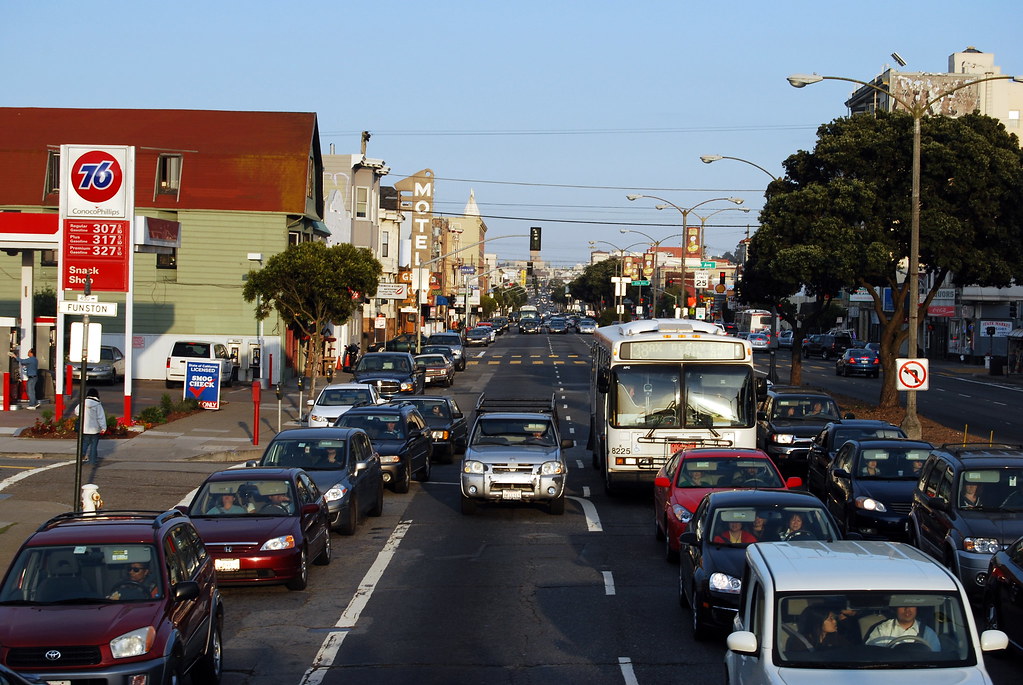At 40 Years, San Francisco’s Transit-First Policy Still Struggles for Traction
from the SF.Streets blog:
At 40 Years, San Francisco’s Transit-First Policy Still Struggles for Traction
by Aaron Bialick

[font size="1"]Four decades after San Francisco's transit-first policy was adopted, Geary Boulevard remains designed to give priority to auto drivers over riders on Muni's busiest bus line. Photo: jivedanson/Flickr[/font]
The first private automobile users on early 20th-century American streets were generally accorded no special privileges on the public right-of-way. “The center of the road was reserved for streetcars, and the new automobiles had to move out of the way,” as Renee Montagne describes it in the 1996 documentary Taken for a Ride, which chronicles the decline of American public transit over the 20th century.
When the San Francisco Board of Supervisors adopted a transit-first policy on March 19, 1973 — 40 years ago this week — a return to the early 1900s streetscape may not have been what they had in mind, but the city’s intent to undo decades of urban planning and governance geared towards promoting driving at the expense of public transit was clear. A key provision of the policy reads, “Decisions regarding the use of limited public street and sidewalk space shall encourage the use of public rights of way by pedestrians, bicyclists, and public transit, and shall strive to reduce traffic and improve public health and safety.” (The policy was amended to include pedestrians and bicyclists in 1999.)
Yet today, the vast majority of San Francisco’s street space remains devoted to moving and storing private automobiles, making the public right-of-way hostile to walking and bicycling. Muni remains underfunded, with vehicle breakdowns and delays caused by car traffic a daily part of riding transit.
“When there’s excess road space that cars don’t need, it’s given over to bikes, peds, and transit,” said Livable City Executive Director Tom Radulovich, “but where there’s a real shortage of road space, in the most congested parts of the city, the car is still the priority.” ......................(more)
The complete piece is at: http://sf.streetsblog.org/2013/03/22/at-40-years-san-franciscos-transit-first-policy-still-struggles-for-traction/
Benton D Struckcheon
(2,347 posts)The original seats put out for pedestrians were inexpensive multicolored plastic lawn chairs, a source of amusement to many New Yorkers. They lasted from the onset of the plaza transformation until August 14, 2009, when they were ceremoniously bundled together in an installation christened "Now You See It, Now You Don't" by the artist Jason Peters.[35] Although the plaza had mixed results on traffic in the area, injuries to motorists and pedestrians decreased, fewer pedestrians were walking in the road and the number of pedestrians in Times Square increased.[36] The plastic chairs were shortly replaced by sturdier metal furniture, and on February 11, 2010, Mayor Michael Bloomberg announced that the pedestrian plazas would become permanent.[37]
from http://en.wikipedia.org/wiki/Times_Square
The basic idea is to make it as close to impossible as you can get to allowing cars into town. Widen the sidewalks, put planters in between the bike lanes and the car traffic lanes to narrow the number of lanes available to cars to the bare minimum, change the timing of the traffic lights to slow car traffic to an absolute crawl, anything that makes it a hassle to use a car in town. The basic rule is that the easier you make it to use a car, the more people will use them, so you have to be merciless in making it as difficult as you can for them to be used.
There was another thread that said the tolltakers on the Golden Gate were being eliminated in favor of electronic tolls. Wrong move. Get those tolltakers back. Those electronic tolls are a convenience to car users. ANY convenience to them is bad.
KamaAina
(78,249 posts)it was to eliminate jobs. Speeding up traffic merely adds insult to injury.
The City, as we call it out here, has been looking at congestion pricing (as has NYC), either establishing a cordon along 16th and Laguna streets (about a mile and a half from downtown) or even setting up tolls at the city's southern edge (its only land border, with only a few key streets and highways crossing it).
A Times Square-style pedestrian mall might extend from the cable car turnaround at Powell and Market up to Union Square, only a couple of blocks but, like Times Square, the heart of tourist activity.
Benton D Struckcheon
(2,347 posts)but someone needs to point out to the city planners that if they intend to give transit the priority everything needs to be looked at in that light, including something like eliminating the toll takers. Speeding up car traffic is not what you want to achieve.